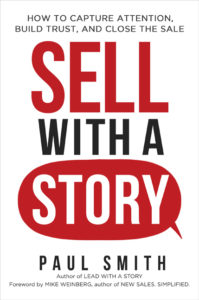Podcast: Play in new window | Download | Embed
Subscribe: RSS
Podcast (lead-with-a-story-podcast-series): Play in new window | Download | Embed
Subscribe: RSS
I once hired a consultant, and the first thing out of his mouth was a lie. Seriously.
I brought him in to lead a 3-day long-term strategy session for my business unit. When he kicked off the first day of meetings, he introduced himself and started into a story about an experience he had at the airport when he arrived the day before. He said,
As I was leaving the terminal to catch a cab, I noticed a police officer writing a ticket for a car that was illegally parked in front of baggage claim.
I watched a man come running out of the terminal and start to yell at the officer. ‘What are you doing? I just stopped for a few minutes to get my bags! Don’t you have anything better to do!’
The officer calmly listened to the man’s tirade, put the ticket under the windshield wiper, and started to write out another ticket. I guess the second one was for being a jerk to a police officer. Well, that sent the man into an even worse tirade filled with all kinds of foul language.
After the officer had written the third ticket, the man finally gave up his fight and stormed back toward the terminal. I stopped him on his way in and asked, ‘Why’d you keep yelling at the police officer? All that got you was more tickets.’ In response, the man just looked at me and smiled and said, ‘Oh, that’s okay. It’s not my car.'”
It was all a big joke. That was his icebreaker. You could almost hear a drummer’s ba-dum crash that always follows a comic’s one-liner. I got the impression he took this story from a joke book and just told it as if it were his own, and as if it were true! There was an awkward silence in the room as people had to mentally transition from hearing what they thought was a true story to politely laughing at a joke.
Don’t get me wrong. There’s nothing wrong with using humor in the workplace. What you want to avoid is leaving your audience feeling betrayed when they thought they were hearing something factual, only to find out they were hearing fiction. Once that happens, you’ve lost all credibility. In my case with the consultant, I was left wondering what else he was going to make up or take credit for during our meetings.
Remember that you’re a business leader, not a comedian or a novelist. You don’t have license to just make stuff up, unless you set the proper expectations that that’s what you’re doing. Our consultant could have told the same story without misleading anyone if he had simply preceded it with, “I heard a funny story the other day about this guy coming out of an airport . . .”
In this case, it was to deliver a joke. But it happens for all kinds of purposes everyday:
- A CEO tells a vision story about a future he knows will never come to pass.
- A salesperson tells an exaggerated story about her product to help make the sale.
- A junior employee tells an embellished story about his accomplishments during his annual performance review.
Where should we draw the line between fact and fiction?
If you’re talking about data, facts, or any specific, quantifiable piece of information, it’s usually pretty clear when you’re giving accurate information and when you’re not. Anything more than a rounding error in your facts is probably over the line.
But stories, whether for leadership purposes, a sales pitch, or a performance review, are more subtle things. Any time a story is recounted, it changes. The human brain is fallible. Some facts will be forgotten, and our brains — without asking us permission — fill in the missing details with guesswork. So, inaccuracies inevitably creep in.
As a result, people expect stories to be somewhat less accurate than numerical data or unconnected facts. But there’s a limit to how many inaccuracies people will accept before they consider you a liar. Remember, you are ultimately responsible for all factual deviations in a story you tell, whether you put them there or not.
After studying storytelling for several years, and documenting thousands of leadership and sales stories, here’s my conclusion: I think you can err on both sides of the issue— meaning, when it comes to guarding the integrity of the facts in your story, I think you can be both too aggressive and too cautious.
If you’re too aggressive, the farther your story will stray from what actually happened, and the more likely you’ll be to mislead your audience, violate their trust in you, and permanently spoil the relationship.
But if you’re too cautious, you’ll avoid using any facts or dialog in your story at all for fear of not being 100% accurate. If you try too hard to use only rigorously supportable statements in your stories, it either neuters them of anything interesting or riddles them with qualifiers and hedges. The result is a boring, useless story. Ultimately all you’d be able to say is, “I woke up, did some stuff, and then came home. The end.”
As a result, the best principle to keep in mind is that in storytelling, accuracy is important; precision is not. Here are some guidelines to help you leverage that principle:
1) You shouldn’t be any more or less willing to embellish stories than you’re willing to embellish facts
A 14.7% sales increase gets rounded up to 15% all the time, and nobody cares. But they won’t feel the same if you rounded it up to 25%. The magnitude of the difference matters. And if you’re willing to make only minor changes to the details of facts, you should be willing to make only minor changes to the details of stories.
2) Set accuracy expectations up front
Your audience will have higher expectations of accuracy the less time has elapsed since the events in the story took place and the fewer mouths the story has passed through. That means a story that starts out, “Yesterday when I arrived at the airport. . .” had better be pretty accurate. A story that starts out, “When I was a kid, somebody told me this story about. . .” will have a much lower expectation of accuracy.
Give the listener some indication up front of how true to the facts they should expect your story to be. “I saw something happen this morning” suggests a high degree of accuracy. “Company legend has it that. . .” suggests a low degree of accuracy.
3) Don’t change the important stuff
Changing minor details doesn’t matter much — things like exact names, dates, locations, or dialog. Sometimes you need to change those things just to protect the innocent (or guilty). And since nobody can remember the exact words in a conversation, you’ll have to paraphrase the dialog. (Dialog is a very powerful storytelling technique. Avoid it at your own peril.)
However, changing the problem the main character ran into, the process they used to overcome it, or the resolution and lesson from a story is a much bigger deal. Don’t do it.
4) Use this litmus test
If ever in doubt, try this: Imagine you just discovered that someone who listened to a story you told was actually there when the story originally happened. Then ask yourself these two questions:
- would they be offended?
- would you be embarrassed?
If yes to either of those, you’ve changed too much. If not, you’re fine.
A last resort . . .
Having said all that, if you ever find yourself in a situation where you need a good story but just don’t have access to all the facts to tell an accurate one, you still have one option left — make one up. That’s right, just make up a completely hypothetical story. It should be a plausible story, of course — the kind of thing that happens all the time. But make it up. It’s okay to tell a made-up story, but only under one condition — your audience knows you made it up. Otherwise, you’re just a liar.
What that means is that you have to tell your audience ahead of time that the story is fictional. A simple introductory phrase like, “Look, I don’t have all the details. So, I’m just going to make this up. But go with me on it, because I think it will help you understand what I’m trying to communicate.” Or you can accomplish all that with a single word — “Imagine . . .” Then tell your hypothetical, but plausible, story. (Click here for an example.)
But remember, this is a last resort. If you haven’t tried to find a true story to communicate your message, you’re doing your audience, and your message, a disservice.
Source: Lead with a Story and Sell with a Story, by Paul Smith.
—
 Paul Smith is one of the world’s leading experts on business storytelling. He’s a keynote speaker, storytelling coach, and bestselling author of the books Lead with a Story, Parenting with a Story, and Sell with a Story.
Paul Smith is one of the world’s leading experts on business storytelling. He’s a keynote speaker, storytelling coach, and bestselling author of the books Lead with a Story, Parenting with a Story, and Sell with a Story.


 Connect with him via email here.
Connect with him via email here.
Follow him on Facebook, LinkedIn, Twitter, and Instagram.
Sign up for his newsletter here to get one new story a week delivered to your inbox.


